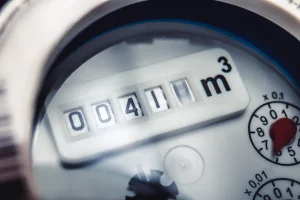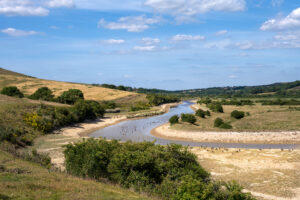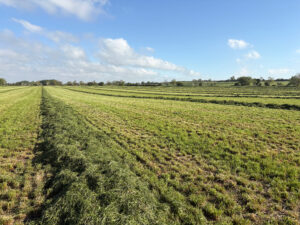In the first part of our ‘A Day in the Life of…’ series, we asked our meter readers what a typical day at work involves.
- Saul Handy, Edinburgh and the Scottish Borders
- Scott Mclaughlin, Ayrshire, Dumfries and Galloway
- Donnie Mackinnon, All Areas (Scotland)
Saul Handy, Edinburgh and the Scottish Borders
My job involves reading meters for most of the day but there are site visits and other tasks that need to be taken care of also.
There are 5 full-time and 2 part-time meter readers that cover the whole of Scotland for Castle Water. Personally, I cover the borders (TD postcode) and all Edinburgh (EH postcodes), except the city. I also have some work to take care of in other areas and, as a team, we help each other when needed.
On a typical day, once the handsome man in the mirror confirms I’m presentable for work, I’ll check my devices are charged, working and I’ll plan my route trying to finish off a particular area.
We do try to cover areas closer to our homes, but this is not always possible and so I can on occasion spend 2 and a half hours getting to my first job.
This means depending on travel time, weather and traffic, I can take from between 5 to 35 reads per day.
Sometimes, we have location issues with overgrown areas restricting our access, flooded meter chambers, vehicles parked over meter chamber lids or road closures – all of which eats into our time. However, we are given around 250 to 600 reads to do a month so as long as I plan ahead and react well to unpredictable changes, it is possible to get the required amount of reads done.
There are various questions that I have to ask myself before I set out: is the TSB open that day; some salons are closed on Mondays, others are closed on Tuesdays; pubs and takeaways open later than other businesses.
All these considerations mean I plan my route with access, time and distance issues in mind. I always check I have an ID, then I’ll check my van, Satnav, PPE and tools.
When arriving at the job, I’ll park safely and perform a quick risk assessment. Most of the time I’ll only be required to speak to customers if their meters are internal. External meters are located mostly on a path, near the road, in a field or on the main road away from the property so we need precise meter locations to find all meters but having locations for rural meters is particularly important.
If I could change anything it would be the rain but the thing that I enjoy most about the job is the scenery. It can surprise you when you come around a bend and if it wasn’t for the rain, Scotland wouldn’t be as beautiful as it is. I moved up here 2 years ago and I still love the sights.
It still surprises me sometimes how I’m clean & pristine when I leave the house but look like a toddler who played in the mud all day when I finish.
Scott Mclaughlin, Ayrshire, Dumfries and Galloway
As Metering and Revenue Officer, I cover all of mainland Scotland and the Islands too. We all have our own designated areas and I cover the areas of Ayrshire, Dumfries and Galloway and part of Lanarkshire.
My main role is to obtain meter reads from various customer locations including shops, offices, schools, factories and farms.
My average day actually starts the day before with some forward planning. As we are allocated our work monthly, we decide between the team how we route plan and what areas we will each cover.
Planning is a must as you have to factor in different scenarios especially the weather and customer requirements.
One example of something us Meter Readers need to consider is business opening hours. There is no point travelling 2 hours on a Monday to cover an area where several of those customers premises will be closed.
The weather can also make the job quite challenging especially heavy rain as the majority of business water meters are fitted externally in underground chambers and are liable to flooding, but you do learn which properties these are and you try to avoid these when the weather isn’t good and visit on the occasional good days we have.
Every day is different and varied and that is what I like about the job as you never know how your day is going to go.
I think the customers like to see us as well and put a face to the company, and we can help with any issues they have there and then. On rare occasion that we can’t help with the issue, we can put them in contact with the correct department to help them out.
The only thing I would change about my job… more sunshine, please.
Donnie Mackinnon, All Areas (Scotland)
My main role is to take scheduled meter readings from our customers as well as conduct ad hoc readings and site visits, for example to gain occupancy details. I cover all areas in Scotland, including the islands and a typical working day for me is 9 am to 5 pm, with 1 hour for lunch.
As a team, we receive our work 1 month at a time via spreadsheets on our smart phones. It is then left to us to schedule and manage our own workload, usually at the end of each day when we return home. We also receive a spreadsheet once a month with transfer reads which we must fit into our schedule.
The number of meter reads I take per day varies a lot. If the reads are all in the same town, then I can potentially take 30+ readings in day. However, if the location is rural or the reads are widespread, then I may only retrieve 15 or less.
The furthest I’ve had to travel to take a meter reading is no more than 2.5 hours. However, if covering the islands such as Harris and Lewis, then I would have to travel 4 hours to catch the ferry, then a further 3.5 to 4-hours for the crossing.
Once on the island, I would then do work over 2-3 days, staying over in a hotel for 3 nights, before embarking on the same journey home.
If the meter is external then we don’t normally need to meet our customers. If internal, we would greet customer then read meter which only takes few minutes to do.
External reads can take anything up to an hour if in a rural location, especially if they are 1st time visits and you have to locate them. Sometimes we will face small challenges in taking a reading for example; animals in fields, long treks over rough terrain etc.
What I love about my job is being able to do my own scheduling, meeting new people and the great scenery of Scotland.



